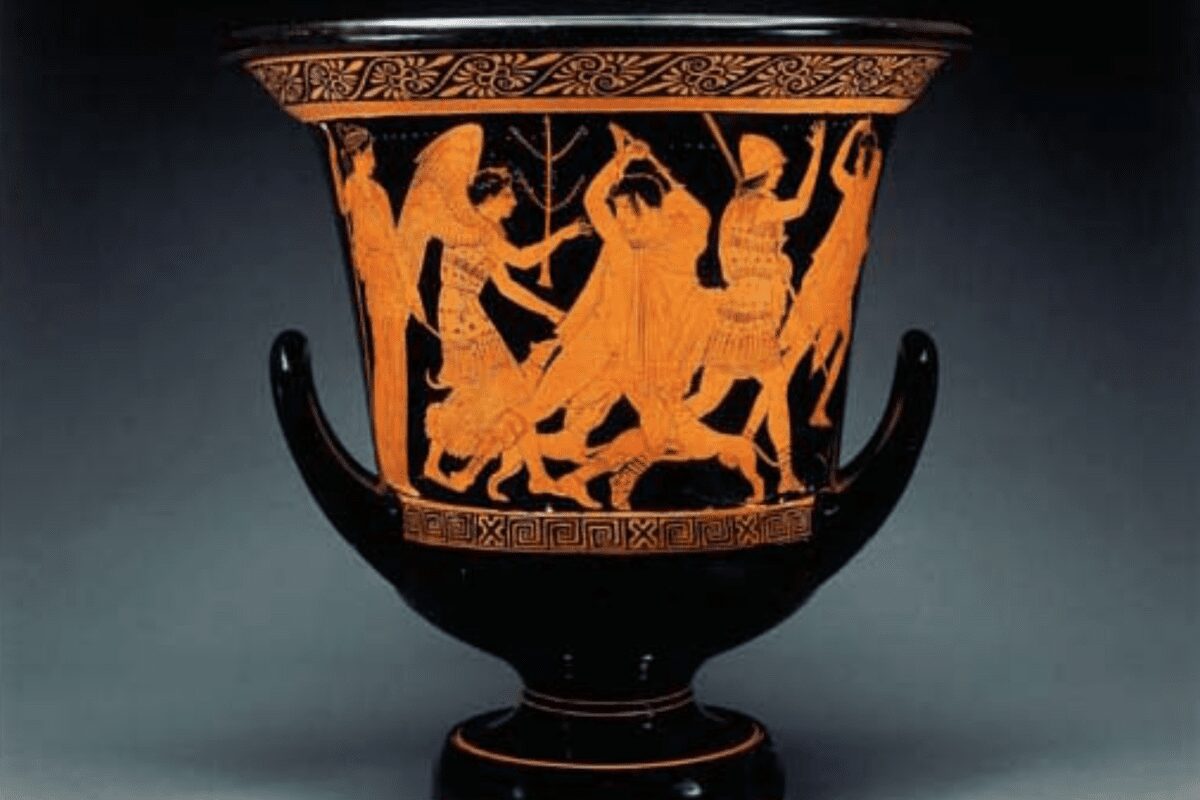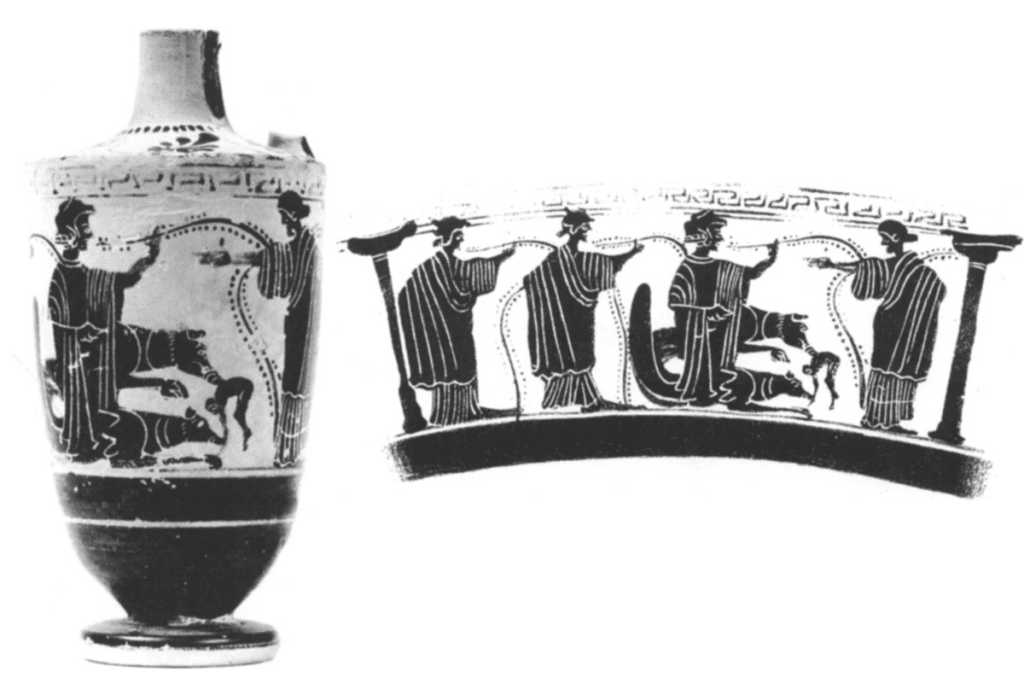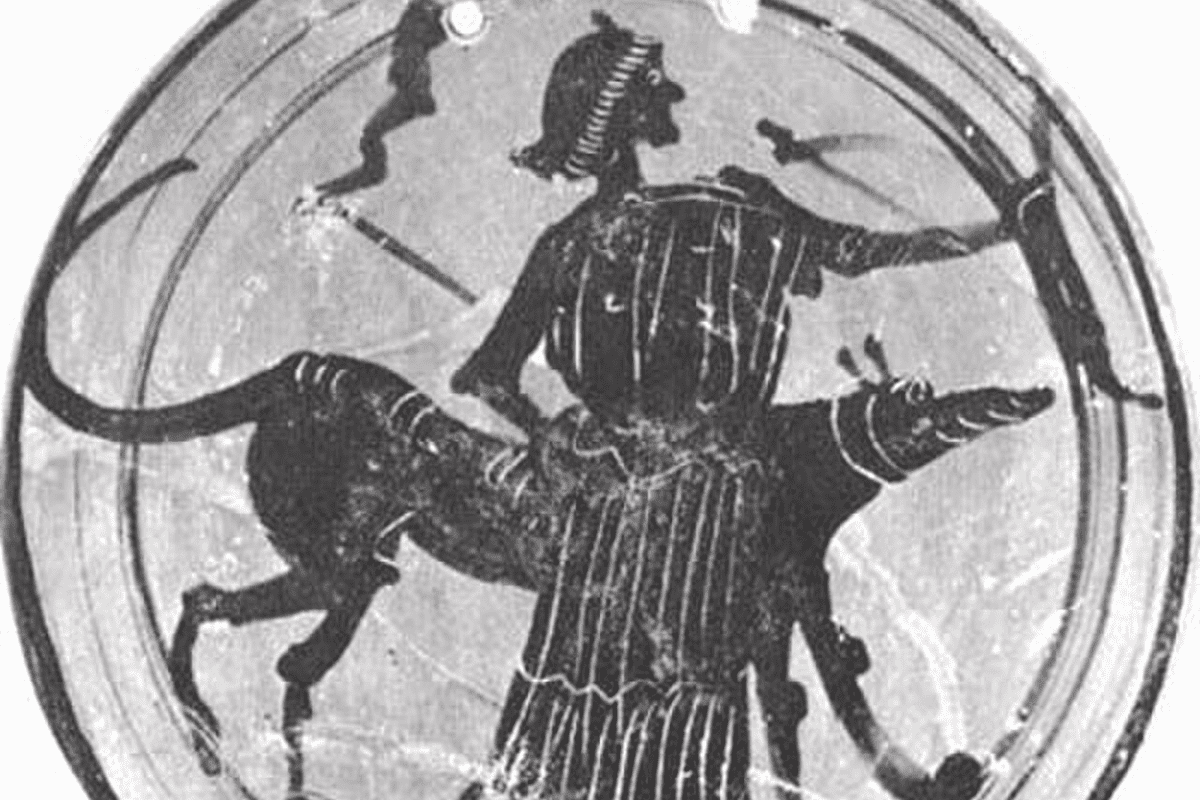Hekate is the ancient Greek goddess of the crossroads associated with witchcraft and the restless dead.
I dedicate October to Hekate with other students and priestesses of the Mt Shasta Goddess Temple. I have a permanent shrine for Hekate, and I perform a monthly ritual to her, my adaptation of the Deipnon. However, she goes on my working altar in October and becomes the centre of my daily morning practice. I spend the month learning more about her, expanding my knowledge, and deepening my practice.
I wrote a few articles about Hekate last year, and here we are again. This article is inspired by an image of Hekate that I came across recently for the first time.
The death of Actaeon

An Attic red-figure calyx-krater (a bowl for mixing wine and water) from c. 430-420 BC auctioned at Christie’s depicts the death of Actaeon. The transgression of the young hunter varies, but the unalterable part of the story is that Artemis, the lunar, virgin goddess of the wild, transformed Actaeon into a stag, and his hounds killed him.
In the scene, Artemis stands holding a strung bow in one hand and a torch in the other, watching as Actaeon transforms into a stag and three dogs surround him. Between the goddess and the hunter stands winged Hekate, “… the goddess ornately clad, reaching out towards the youth, the head and fore-paws of a dog (with which she is associated) emerging from the crown of her head, which is framed by short white strokes perhaps evoking the dog’s barking…”.
What is Hekate doing here?
Before we try answering this question, let’s look at the elements associated with Hekate in this scene: Artemis, dogs, transformation, and the dead.
Hekate and Artemis (and Selene)
Hekate and Artemis share some characteristics and epithets. Both have been depicted in short tunics, holding torches, with dogs, and are associated with childbirth and the moon. Their associations with the moon also led to their identification with Selene, the Greek personification of the moon.
“We pray that other guardians be always renewed, and that Artemis-Hekate watch over the childbirth of their women.” -Aeschylus
Sometimes Hekate, Artemis, and Selene were treated as individual beings and invoked together or worshipped as a group. Sometimes they were treated as the same or as different aspects of the same. The conflation was strongest during the Roman era, but it has remained with us. Some contemporary practitioners view Hekate, Artemis, and Selene as a Triple Goddess associated with different moon phases.
I see Hekate, Artemis, and Selene as three distinct goddesses. They have some things in common, just as you and I might, but they have different histories, temperaments, and divine duties.
Her sacred animal, the dog
Dogs were closely associated with Hekate. One myth tells us that Queen Hecuba leapt into the sea after the fall of Troy, and Hekate transformed her into a dog and her companion.
Hekate has various epithets associating her with dogs, and their howling heralded the goddess’s approach. In the Roman era, Hekate was sometimes depicted with a dog’s head. Dogs were often associated with goddesses of birth, which Hekate is also sometimes connected to.
Dogs are a common motif in ancient Greek funerary art, and Hekate’s dogs are not all your average friendly canine companions. Despite their docile appearance in art, Hekate’s hounds were understood to be the manifestations of the restless souls that accompany her.
The psychopomp
Hekate doesn’t star in many stories, and the Homeric Hymn to Demeter is perhaps her most well-known literary appearance. In the hymn, Hekate and the sun god Helios heard Persephone’s cries when Hades abducted her. When Hades returned Persephone, Hekate embraced her and became her companion on her annual journey to and from the Underworld.
Here, Hekate serves as a psychopomp, a “guide of souls” whose responsibility is to escort the newly deceased to the Underworld. One of her epithets is Kleidoukhos, Keeper of the Keys, and, as a cthonic and liminal goddess, Hekate can unlock the gates between realms.
Like the messenger gods Iris and Hermes, Hekate’s wings show she can go anywhere.
Leader of the restless dead
Literary sources emphasise the necessity of a proper burial for a successful passage into the afterlife. Furthermore, the living needed to continue tending properly to their dead by maintaining their gravesites, making offerings, and commemorating them. Otherwise, their beloved dead could become hungry ghosts.
Thanks to her associations with boundaries and the Underworld, Hekate became strongly associated with ghosts. Offerings to Hekate were for protection from the restless dead.
Back to the death of Actaeon
Let’s return to the death of Actaeon. In various versions I’ve read, the myth tells us that Artemis turned the hunter into a stag, and his dogs killed him. I don’t recall any mention of Hekate. So, what is Hekate doing on this bowl?
Is she there as a goddess of liminality, a witness to his transformation? Torn and devoured, it’s probably safe to say that Actaeon didn’t receive the necessary burial rites to ensure his passage into the Underworld. So, she’s not there to be his psychopomp. Is Hekate there to welcome him in her retinue of restless ghosts? Maybe. Could it be that Hekate is on the scene to sic Actaeon’s dogs on him?
An Athenian black-figure lekythos in the National Archaeological Museum of Athens depicts a female figure with two dogs devouring a small human figure in the presence of three other female figures. In 1972, the Greek classical archaeologist Semni Karouzou identified the figure with the dogs as Hekate punishing a human shade in the Underworld and the other three female figures as the Erinyes, chthonic goddesses of vengeance.

Hekate and punishment
Hekate is not explicitly a goddess of justice or vengeance like deities such as Themis, Dike, Athena, and the Erinyes, but she is associated with revenge and dispensing punishment.
Circe and Medea used the skills they learned from Hekate to punish those who crossed them. Medea escaped in Hekate’s chariot. The souls in Hekate’s wake long for vengeance. And the spells of the Greek (PGM) and Demotic magical papyri (PDM) and the defixiones, or curse tablets and binding spells, commonly invoked Hekate.
When we look at her relationships with Persephone, Hecuba, and Galinthias, Hekate is more often depicted as a kind, sympathetic, and protective figure. She is rarely seen doling out punishment herself, but the scenes depicted on these vessels could show some exceptions.

